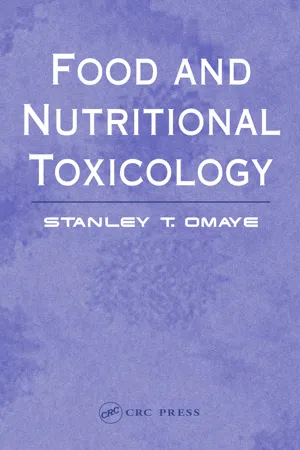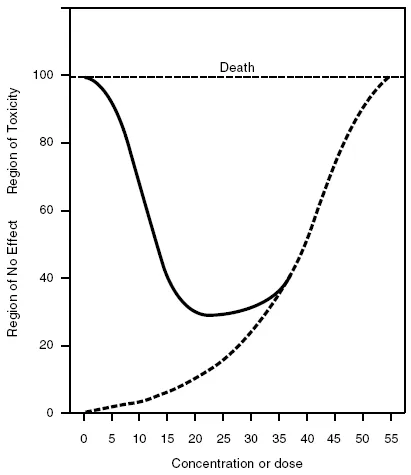
- 336 pages
- English
- ePUB (mobile friendly)
- Available on iOS & Android
eBook - ePub
Food and Nutritional Toxicology
About this book
Food and Nutritional Toxicology provides a broad overview of the chemicals in food that have the potential to produce adverse health effects. The book covers the impact on human health of food containing environmental contaminants or natural toxicants, food additives, the migration of chemicals from packaging materials into foods, and the persisten
Frequently asked questions
Yes, you can cancel anytime from the Subscription tab in your account settings on the Perlego website. Your subscription will stay active until the end of your current billing period. Learn how to cancel your subscription.
No, books cannot be downloaded as external files, such as PDFs, for use outside of Perlego. However, you can download books within the Perlego app for offline reading on mobile or tablet. Learn more here.
Perlego offers two plans: Essential and Complete
- Essential is ideal for learners and professionals who enjoy exploring a wide range of subjects. Access the Essential Library with 800,000+ trusted titles and best-sellers across business, personal growth, and the humanities. Includes unlimited reading time and Standard Read Aloud voice.
- Complete: Perfect for advanced learners and researchers needing full, unrestricted access. Unlock 1.4M+ books across hundreds of subjects, including academic and specialized titles. The Complete Plan also includes advanced features like Premium Read Aloud and Research Assistant.
We are an online textbook subscription service, where you can get access to an entire online library for less than the price of a single book per month. With over 1 million books across 1000+ topics, we’ve got you covered! Learn more here.
Look out for the read-aloud symbol on your next book to see if you can listen to it. The read-aloud tool reads text aloud for you, highlighting the text as it is being read. You can pause it, speed it up and slow it down. Learn more here.
Yes! You can use the Perlego app on both iOS or Android devices to read anytime, anywhere — even offline. Perfect for commutes or when you’re on the go.
Please note we cannot support devices running on iOS 13 and Android 7 or earlier. Learn more about using the app.
Please note we cannot support devices running on iOS 13 and Android 7 or earlier. Learn more about using the app.
Yes, you can access Food and Nutritional Toxicology by Stanley T. Omaye in PDF and/or ePUB format, as well as other popular books in Medicine & Nutrition, Dietics & Bariatrics. We have over one million books available in our catalogue for you to explore.
Information
Section I
Fundamental Concepts
1 An Overview of Food and Nutritional Toxicology
DEFINING THE TERMS AND SCOPE OF FOOD AND NUTRITIONAL TOXICOLOGY
TOXICOLOGY
In essence, toxicology is the science of poisons, toxicants, or toxins. A poison, toxicant, or toxin is a substance capable of causing harm when administered to an organism. Harm can be defined as seriously injuring or, ultimately, causing the death of an organism. This is a rather simplistic definition, because virtually every known chemical or substance has the potential for causing harm. The term toxicant can be a synonym for poison, or the term poison might be more appropriate for the most potent substances, i.e., substances that induce adverse effects at exposure levels of a few milligrams per kilogram of body weight (see later discussion). The term toxin usually refers to a poison derived from a protein or conjugated protein produced by some higher plant, animal, or pathogenic bacteria that is highly poisonous for other living organisms, e.g., botulinum toxins. Toxicologists study the noxious or adverse effects of substances on living organisms or on in vitro surrogate models, such as cell and tissue cultures. The substances toxicologists study are usually chemical compounds but may be elemental or complex materials. Radioactive elements, heavy metals (e.g., mercury or lead), or the packing materials used in food processing are examples of such substances. Food toxicology deals with substances found in food that might be harmful to those who consume sufficient quantities of the food containing such substances. On rare occasions, common foods are contaminated with unacceptably high levels of toxicants. Such substances can be inherent toxicants, substances naturally found in foods, or contaminants, which are substances that find their way into food either during the preparation or processing of such foods.
Nutritional toxicology is the study of the nutritional aspects of toxicology. Nutritional toxicology is related to and might even overlap but is not synonymous with food toxicology. Food toxicology emphasizes toxicants or toxins found in foods, whereas nutritional toxicology targets the interrelations that toxicants or toxins have with nutrients in the diet, which affect nutritional status. Nutritional toxicology can refer to the means by which the diet or components of the diet prevent against the adverse effects of toxicants or toxins.
It is likely that the first experience humans had with toxicology was with a toxicant found in food. The science of toxicology has been studied since antiquity, starting when humans first realized that they had to be cautious with food selection or suffer dire consequences. Our ancestors probably learned from trial and error and by observation about which food sources satisfied hunger and which led to illness or death. As illustrated in the cartoon in Figure 1.1, early humans were quick to either learn or suffer the consequences of deciding whether to eat a plant where dead animals lay. Thus, our ancestors developed dietary habits that allowed for the survival, growth, and reproduction of the species.

FIGURE 1.1 Early humans: What to eat?
Hemlock and various other poisons were known and studied by the ancient Greeks. The fundamental concept of toxicology — the dose determines the poison — was conceived by Paracelsus (1493 to 1541) and based on his commentary that all substances are poisons; there is none which is not a poison and the right dose determines the poison from a cure. Therefore, the premise that anything has the potential to be a poison if taken in a large enough dose dictates the scope of toxicology, which is to quantitate and interpret the toxicity of substances. Most toxicologists deal with exogenous compounds, or those compounds that are not part of the normal metabolism of organisms, i.e., xenobiotic or foreign compounds. Food and nutritional toxicologists deal with toxicants in food, the health effects of high nutrient intakes, and the interactions between toxicants and nutrients.
FOOD AND NUTRITIONAL TOXICOLOGY
Development of toxicology as a distinct science has been slow as compared with the sciences of pharmacology, biochemistry, and nutrition. Many toxicologists were trained in other disciplines and subsequently were rich in diversity. Food and nutritional toxicology can be considered an emerging subdiscipline of toxicology. The area of food and nutritional toxicology bridges traditional sciences and can be regarded as a branch of either nutrition, food science, or toxicology. In addition, there are significant contributions from other sciences, both new and emerging, to food and nutritional toxicology, e.g., behavior sciences, epidemiology, molecular biology, environmental sciences, public health, immunology, and microbiology. In the following chapters we will discuss some current research that deals with the effects, both good and bad, of food components on the modulation of the immune response or alterations of behavior.
Food safety is another area that can be encompassed within food and nutritional toxicology. Within the food safety arena we deal with the regulatory and consumer or economic implications of toxicity issues related to our food supply. Our concerns about food safety are not new. Around the time of the Civil War, W.O. Atwater warned in Harper’s Weekly that city people were in constant danger of buying unwholesome meat and finding meat coated with glycerine to give it the appearance of freshness. It was common at that time to find milk diluted with water, coffee adulterated with charcoal, or cocoa mixed with sawdust. Upton Sinclair’s The Jungle was a startling wake-up call and prompted the start of governmental controls on the food industry. Even at present, it seems that there are reports almost daily of a food or food constituent whose safety has come under scrutiny. So sometimes it is hard not to succumb to the belief that a food safety crisis exists; however, when these concerns and claims are put into perspective, one can understand why the U.S. still has the safest, cheapest, and most varied food in the world.
TOXICANTS IN FOODS AND THEIR EFFECTS ON NUTRITION
Potential sources of toxicants in food include nutrients, natural food toxicants, contaminants, and chemicals or substances intentionally added to food (food additives).
NUTRIENTS
One usually does not relate the ingestion of a specific nutrient with concerns about the toxicity of that nutrient. However, intakes of essential dietary chemicals from zero to excessive produce responses, from lethal because of nutrient deficiency to an optimal health response and back to lethal because of intolerably high concentrations. Thus, as the solid line in Figure 1.2 illustrates, an organism cannot tolerate either of the two extremes over an extended period. The figure illustrates that there will be intakes, both low and high, associated with lethality. Also, there will be minimum low and maximum high intakes associated with good health and a valley associated with optimal health. The valley of the curve for optimal health will vary, depending on a number of physical, biochemical, or physiological effects of the nutrient. For example, the intake level of vitamin E for optimal health has a rather wide valley compared with that for intake levels of vitamin D, vitamin A, or various essential metals for optimal health.

FIGURE 1.2 Concentration (dose) effect of nutrients (solid line) compared with a typical dose–response curve (dashed line).
With the exception of vitamin D, vitamin A, and some minerals, the intake of nutrients from natural food sources will not pose any significant health problems. However, one can argue that the health problems associated with high intakes of protein, fats, or energy are really manifestations of nutrient toxicity, i.e., cardiovascular diseases, cancers, and eye diseases such as macular degeneration and other chronic diseases. The other potential means whereby nutrient intakes can present health problems is the abuse of nutrient supplementation. A nonfood source of a nutrient can produce pharmacological actions at concentrations well above normal dietary amounts.
Over the last few years, dietary reference intakes (DRIs) have been developed by the Food and Nutrition Board of the National Academy of Sciences. The premise for developing DRIs is that such values reflect the current knowledge of nutrients, particularly with respect to their role in diet and chronic diseases. Similar to recommended dietary allowances (RDAs), DRIs are reference values for nutrient intakes to be used in assessing and planning diets for healthy people. A vital component involved in the development of DRIs is the value for tolerable upper level (UL). UL may be defined as the point beyond which a higher intake of a nutrient could be harmful. UL is the highest level of daily nutrient intake that is likely to pose no risk of adverse health effects in almost all individuals in a specified life stage group. The interest in developing ULs is partly in response to the growing interest in dietary supplements that contain large amounts of essential nutrients; the other concern is the increased fortification of foods with nutrients. For example, for vitamin C and selenium, the UL refers to total intake from food, fortified food, and nutrient supplements, whereas for vitamin E it might refer only to intakes from supplements, pharmacological agents, or their combination. Often, ULs apply to nutrient intake from supplements because it would be extremely unusual to obtain such large quantities of a specific nutrient in food form.
A risk assessment model was used to derive specific ULs, which included a systematic series of scientific considerations and judgements. The ULs were not intended to be recommended levels of intake because there are little established benefits for healthy individuals if they consume a nutrient in amounts greater than the RDA. Also, the safety of routine long-term intakes above the UL is not well established. The objective of ULs is to indicate the need to exercise caution in consuming amounts greater than the recommended intakes. It does not mean that high intakes pose no risk of adverse effects.
NATURALLY OCCURRING TOXICANTS
The notion that potentially toxic substances can be commonly found in conventional foods is difficult for the layperson and some well-educated people to accept. On an emotional level, food is regarded as that which sustains life, should be pure, unadulterated, and sometimes has a spiritual aura. Thus, many individuals are astonished to find that plants and some animals that are sources of food can produce an array of chemicals that can be harmful. There are some notable examples. A well-acknowledged naturally occurring toxicant is the toxin produced by the puffer fish, Fugu rubripes, which is popular in Japanese cuisine. Another example is the poisonous mushroom Amanita muscaria. The production of toxicants is more common than one might first realize. Plants produce both primary and secondary metabolic products. In the plant kingdom, many phytochemicals are produced as secondary metabolites, e.g., metabolic by-products of metabolism, excretion, and elimination. Through evolution, some of these secondary metabolites have become important defense chemicals used by the plant against insects and other organisms. The plant’s weapons are not as technological as the one shown in the cartoon in Figure 1.3, but many are quite sophisticated biochemically. Primary metabolites are chemicals that have key roles in important physiological plant processes such as photosynthesis, lipid-energy and nucleic acid metabolism, and synthesis. It is likely that secondary metabolites evolved in response to and interaction with organisms of the animal and plant kingdoms or certain herbivores and pathogens. Recent advances in genetically modified foods have used such knowledge for developing plants with the ability to better defend themselves against disease and predators.
FOOD ADDITIVES AND CONTAMINANTS
A wide variety of chemicals enter foods during processing either because they are intentionally added or the food becomes contaminated with various substances. Food additives include chemical preservatives such as butylated hydroxytoluene (BHT) and nitrite and microbial retardants such as calcium propionate. The food industry adds chemicals as texturing agents and flavors. Various chemicals may enter the food chain at different stages of processing, such as residues from fertilizers, pesticides, veterinary pharmaceuticals and drugs, and environmental chemicals such as lead or polychlorinated biphenyl (PCB). Some additives are generally recognized as safe (GRAS) items and require no testing for safety. Others require a battery of tests to ensure their safety for use in consumer foods.

FIGURE 1.3 Plants have natural weapons.
Food additives can provide many benefits for the consumer and the food producer. Longer shelf life is advantageous not only to the producer but also to the consumer, for whom a longer shelf life means lower prices, reduced spoilage and waste, and fewer trips to the grocery store to stock up. However, some may argue whether such convenience is a benefit or a ploy by the industry to use more of their products. There are a multitude of reasons for using additives, some less meritorious than others (green catsup, anyone?). The bottom line is whether the product is safer with the additive present. Does the product have nutritional negatives, i.e., is it less nutrient dense or higher in saturated fats?
IMPACT OF DIET ON THE EFFECTS OF TOXICANTS
For several decades, nutritional research was concentrated on establishing a better understanding of macronutrients and micronutrients. The lack or deficiency of any specific nutrient will have devastating health ramifications. The lack of any specific nutrient in the diet may affect protein synthesis. It may produce membrane alteration, resulting in the loss of cellular structural integrity and changes in membrane permeability or various functional abilities of various macromolecules, which can subsequently affect the ability of the organism to metabolize various toxicants. Several nutrients have been recognized for their roles in protecting against the toxic effects of noxious chemicals such as alcohol and free radicals. Recent research has directed our attention to studying other chemicals in the diets, studying phytochemicals, and reexamining how macro- and micronutrients may modulate our response to various toxicants. Specific phytochemicals have been found to act as anticancer agents and antioxidants, and to have other potential health benefits. However, with these exciting advances in nutrition and health will arise concerns about safety and efficacy that must be addressed. Thus, with such advances, we can expect to see the field of food and nutritional toxicology at the forefront, addressing issues of mechanisms of action, risk, and safety and what is appropriate for optimal health.
STUDY QUESTIONS AND EXERCISES
- Define toxicology, food toxicology and nutritional toxicology, phytochemical, and toxin.
- Describe how toxicants might affect nutrition and health.
- How might an organism’s diet impact on the effects of a toxicant?
RECOMMENDED READINGS
Hatchcock, J.N., Nutritional Toxicology, Academic Press, New York, 1982.
Institute of Medicine, Food and Nutrition Board, Dietary Reference Intake, National Academy Press, Washington, D.C., 1997, 1998, 2000, 2001, and 2002.
Jones, J.M., Food Safety, Egan Press, St. Paul, MN, 1992.
Ottoboni, M.A., The Dose Makes the Poison, 2nd ed., John Wiley & Sons, New York, 1997.
Shibamoto, T. and Bjeldanes, L.F., Introduction to Food Toxicology, Academic Press, San Diego...
Table of contents
- Cover Page
- Title Page
- Copyright Page
- Preface
- Acknowledgments
- Section I Fundamental Concepts
- Section II Toxicants Found in Foods
- Section III Food Contamination and Safety